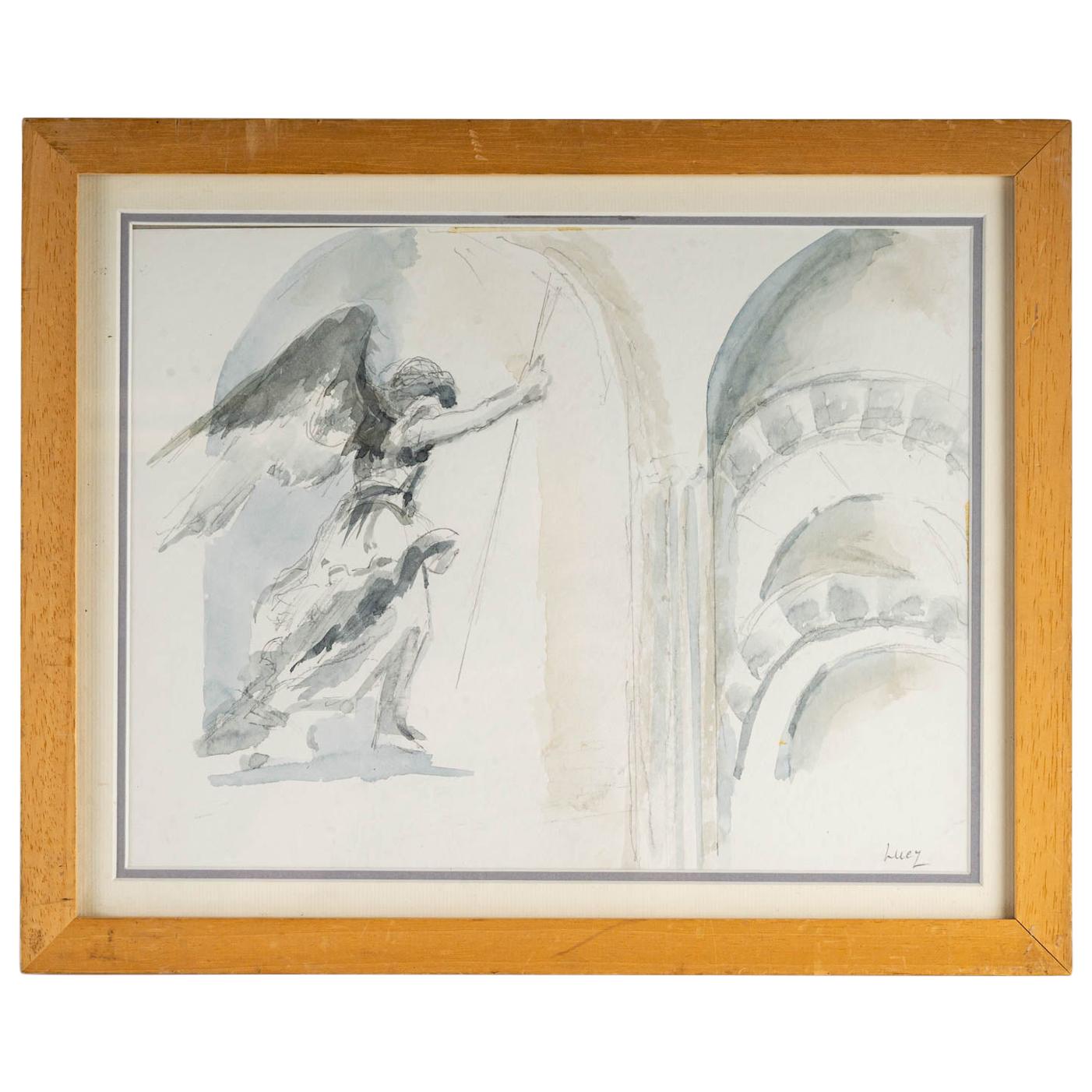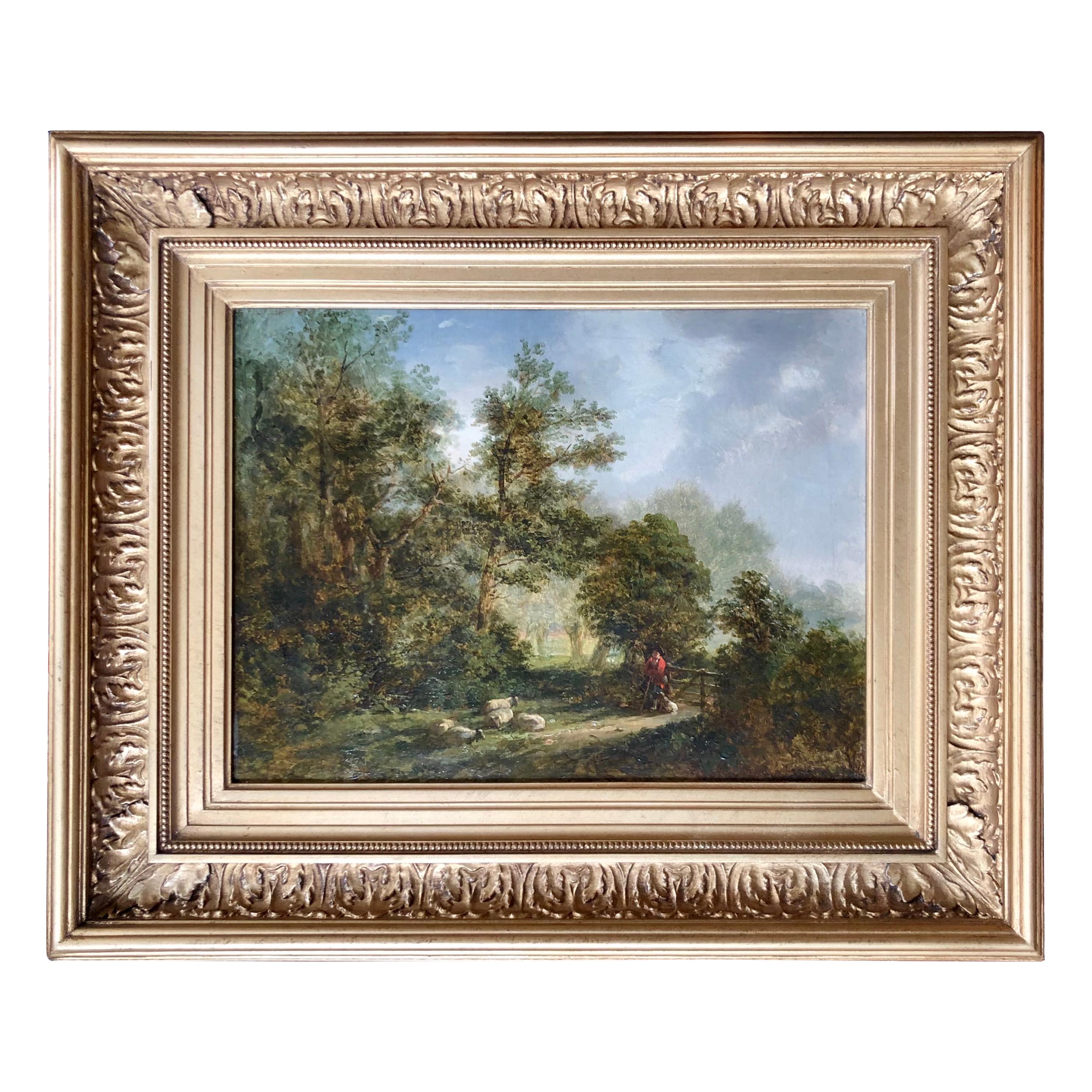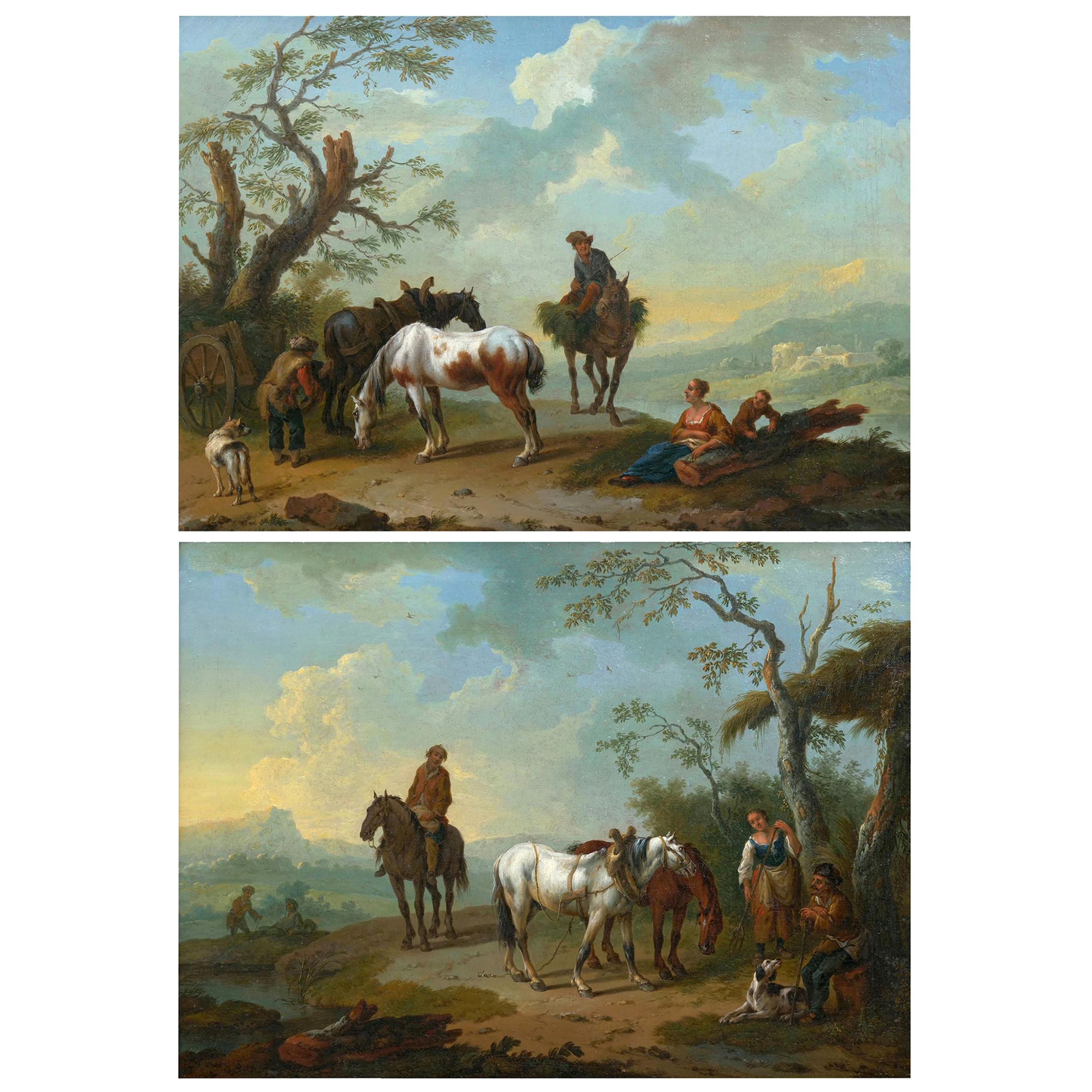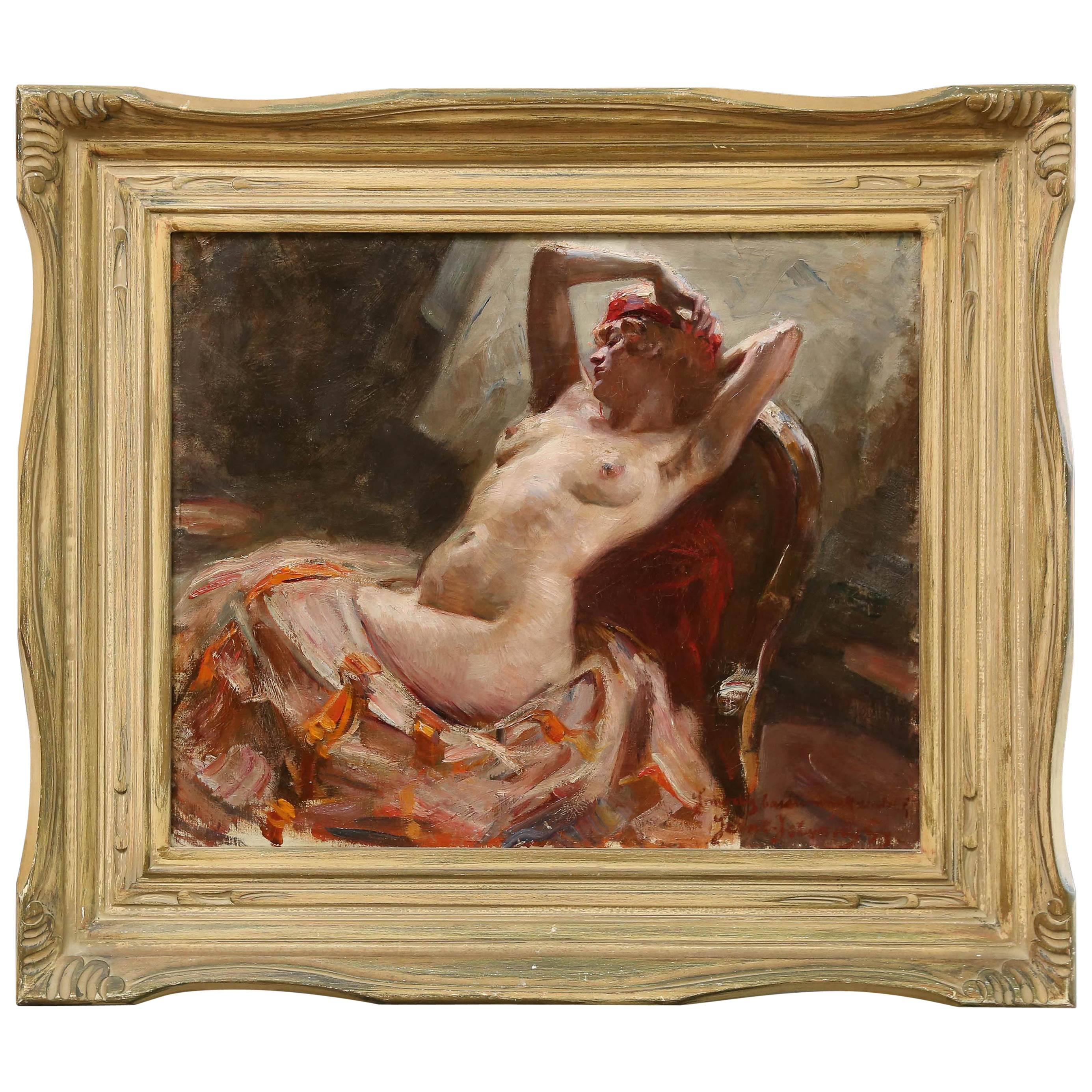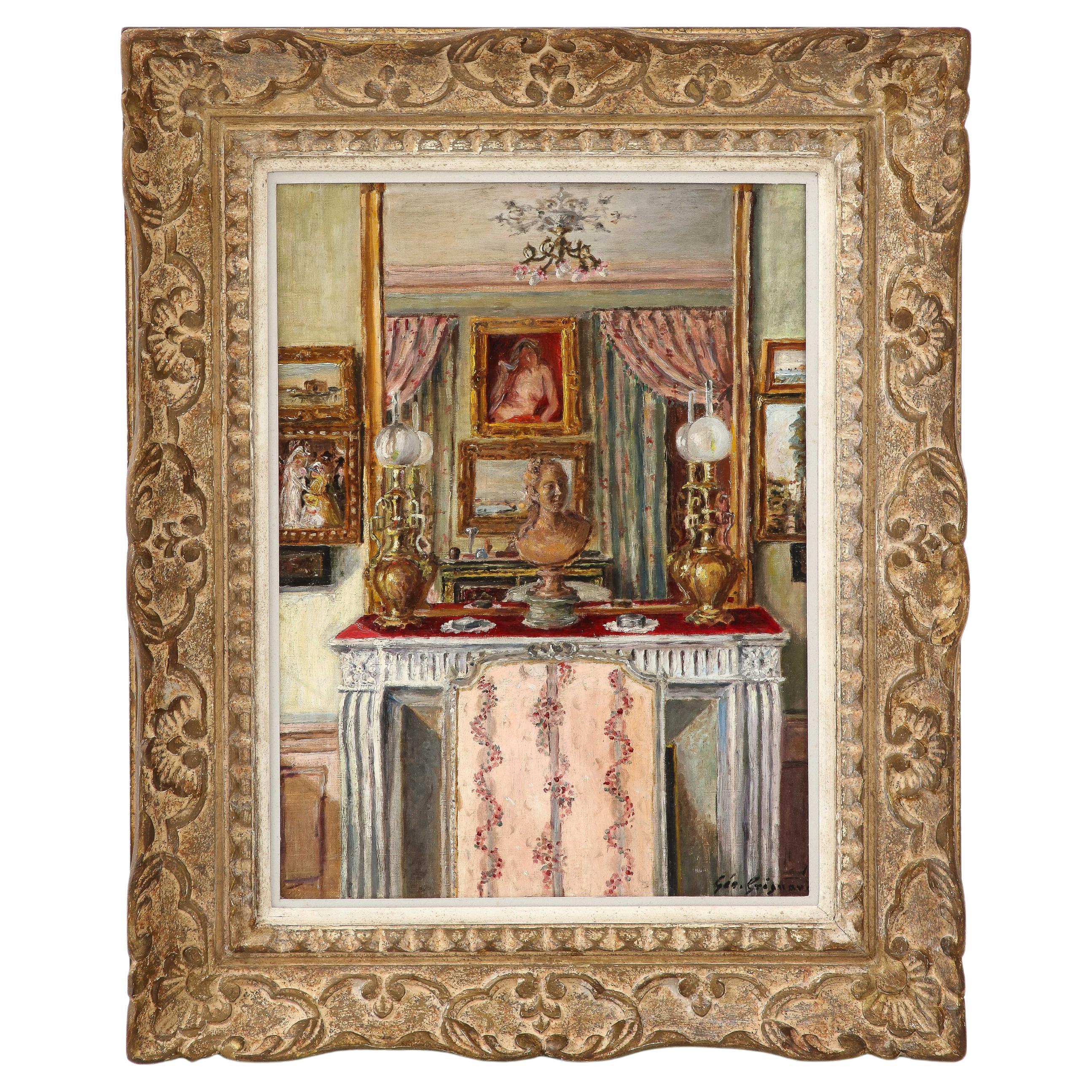Items Similar to Elegant Musical Party in an Interior’ Attributed to Gillis Van Tilborgh
Want more images or videos?
Request additional images or videos from the seller
1 of 6
Elegant Musical Party in an Interior’ Attributed to Gillis Van Tilborgh
About the Item
An Elegant Musical Party in an Interior’ attributed to Gillis van Tilborgh, oil on canvas depicting a Dutch genre scene with figures dressed in rich silk clothing, fine lace ruffs and fichu collars grouped round musicians playing a clavichord, a fiddle and a flute, some couples holding hands or sitting close together and a baby playing on the floor, with a plaque reading ‘Gerard Terburg 1608-1681’, the reverse with a chalk notation ‘Ld Hesketh’. Dutch, circa 1870.
Provenance: George, 3rd Earl of Pomfret (1768-1830), or his brother The Hon. Thomas Fermor, later 4th Earl of Pomfret (1770-1833), Easton Neston.
Thence by descent, Lord Hesketh, Easton Neston.
His Sale, Sotheby’s London, 17-19 May 2005, lot 82. Private Collection.
Literature: George Baker, ‘The History and Antiquities of the County of Northamptonshire’ 1838, part IV, p.145, as ‘Flemish Musical Party, Palamedes’, and hanging in the Music Room; Philips & MacConnal, 1919, p.1, item 4, as ‘Given to Gerard Terburgh’ and hanging in the Picture Hall.
Historical Significance. ‘Genre scenes such as these merrymaking tavern interiors were invented during the seventeenth century in the Low Countries. The newly proclaimed Dutch Republic sought independence from their Spanish rulers, establishing their own trade routes around the world. The treasures, spices and goods brought back to Amsterdam made it the busiest port in Europe and made the Dutch Republic the wealthiest nation on Earth. This unprecedented influx of wealth resulted in an endless appetite for fine art. Famous artists such as Rembrandt, Rubens, Teniers & Frans Hals made their fortune in response to the market, and for the first time, paintings were made on speculation rather than by commission. Genre scenes such as the present painting belonged to this new category as they appealed to a great number of wealthy citizens. Imbued with a moral message of love and lust, the familiar setting of a tavern interior, with people dressed just like you, made them an incredibly exciting and vivid experience to behold. Dutch seventeenth century paintings are particularly celebrated for their realism, famously described as “the art of describing.” In fact, the tavern scene is depicted with such attention to detail that Van Tilborgh has included other ‘real’ paintings on the wall in the background, including a rendition of Peter Paul Rubens’ Angelica and the Hermit, which Van Tilborgh would have personally seen in Rubens’ home in Antwerp.
Gillis van Tilborgh, taught by the most famous Flemish painter of the 17th century, David Teniers, became a member of the important Saint Luke Painters’ Guild in Brussels in 1654, when he set up his own successful studio. Specialising in group portraits and genre scenes, Van Tilborgh’s use of colour is lively, with reds and blues reminiscent of Teniers. His success brought him to England around 1670, taking commissions from English aristocracy.
Easton Neston, the seat of the Hesketh-Fermor family for nearly 500 years, was home to an unrivalled collection of works of art, dating from as far back as the Tudor period.
Framed Height 53 ½ inches Width 64 inches
Canvas Height 39 ¼ inches Width 50 inches.
- Dimensions:Height: 53.5 in (135.89 cm)Width: 64 in (162.56 cm)Depth: 1 in (2.54 cm)
- Materials and Techniques:
- Place of Origin:
- Period:
- Date of Manufacture:circa 1870
- Condition:Wear consistent with age and use.
- Seller Location:Lymington, GB
- Reference Number:1stDibs: LU973030929962
About the Seller
5.0
Recognized Seller
These prestigious sellers are industry leaders and represent the highest echelon for item quality and design.
Established in 1982
1stDibs seller since 2013
108 sales on 1stDibs
Typical response time: 2 hours
Associations
LAPADA - The Association of Arts & Antiques Dealers
- ShippingRetrieving quote...Ships From: Lymington, United Kingdom
- Return PolicyA return for this item may be initiated within 14 days of delivery.
More From This SellerView All
- An unusual George IV specimen marble backgammon table attributed to GillowsBy Gillows of Lancaster & LondonLocated in Lymington, HampshireAn unusual George IV specimen marble backgammon table attributed to Gillows. This rectangular table is strongly attributed to Gillows. It has a rectangular top inlaid with a central chess board flanked by two backgammon fields, all inlaid with a multitude of specimen marbles. One edge carved and gilded with the Latin motto ‘Turpe est in patria vivere et patriam ignorare’. The oak base has a drawer for cards and playing pieces, all raised on a square section support with four splayed legs and the original brass castors. English, circa 1830. Provenance: Geoffrey Bennison Ltd, London, November 1983 The Mermaid House Collection, St. John’s Wood, London Property of a gentleman Private American collection The form of the base of this table is related to several known Gillows commissions from the late Regency period and the quality of the cabinet work also suggests that firm attribution to the firm. Backgammon tables, rather than more general games tables, are unusual at this date and the use of inlaid specimen marbles in the top suggests a client of wealth. Additionally, the Latin text on the edge of the table provides further clues. The text, Turpe est in patria vivere et patriam ignorare, translates as “it is shameful to live in your homeland and not know it”. This phrase dates back to antiquity but rose to prominence once again in the mid-18th century when used by the botanist and key Enlightenment figure Carl Linnaeus in his work on the native flora of Sweden. The combination of this phrase and the use of native English timbers and marbles is promoting English raw materials and craftsmanship at a time when the noble and the wealthy were focussed on European pietra dura tables. Mermaid House in St John’s Wood was re-designed by Chester Jones...Category
Antique 1830s English George IV Game Tables
MaterialsMarble
- An oak and pollard oak writing table attributed to George Bullock with designs bBy George BullockLocated in Lymington, HampshireAn oak and pollard oak writing table attributed to George Bullock with designs by draughtsman Thomas Wilkinson, the rectangular top with a small gallery on three sides, the centre with a hinged and ratchetted reading slope, all above a panelled frieze with one long drawer, decorated with asymmetrical pollard oak veneers, with a border of ovals and spheres within crossbanding and ebony stringing, all raised on unusual graduated bead legs...Category
Antique 1840s English Tables
MaterialsOak
- Centre Table Attributed to Holland and Sons Related to a Table in Clarence HouseLocated in Lymington, HampshireA centre table attributed to Holland and Sons related to a table in Clarence House, this exceptional table has a circular top decorated with six radiating amboyna veneers with a border of concentric marquetry rings. The decoration comprising kingwood bands within boxwood stringing, a continuous boxwood laurel wreath with ivory berries on a satinwood ground and further amboyna borders. The frieze has amboyna crossbanding and applied ormolu sunburst medallions. The support is composed of purpleheart columns inlaid with kingwood, terminating in low splayed feet, which encircle a classical urn on a plinth. The superb ormolu mounts include acanthus leaves, classical masks and patera. English, circa 1860. A table with a similar base and particularly fine ormolu mounts was exhibited by Holland and Sons in the International Exhibition in 1862 and illustrated as plate 40 in J. B. Waring’s book (see pages 100-103 for further references to this exhibition). A further closely related piece was in the collection of the late Queen Elizabeth the Queen Mother and is shown in the Morning Room in Clarence House in the Daily Mail’s article ‘Inside the private world of Prince Charles’, November 2018. Originally founded by Stephen Taprell and William Holland...Category
Antique 1860s English Center Tables
MaterialsBoxwood, Kingwood, Satinwood, Amboyna
- A Regency rosewood bookstand attributed to GillowsBy Gillows of Lancaster & LondonLocated in Lymington, HampshireA Regency rosewood bookstand attributed to Gillows, of rectangular form with a gallery of turned spindles on three sides terminating in two scrolls and surmounted by two carrying han...Category
Antique 1810s English Regency Bookends
MaterialsRosewood
- Regency Rosewood Book Tray Attributed to GillowsBy Gillows of Lancaster & LondonLocated in Lymington, HampshireA Regency rosewood book tray, circa 1815, attributed to Gillows, the turned spindle three quarter gallery incorporating a pair of pierced handles, above the ...Category
Antique 19th Century British Regency Bookends
MaterialsRosewood
- A Victorian kidney shaped desk in richly figured burr walnut, attributed to GillBy Gillows of Lancaster & LondonLocated in Lymington, HampshireA Victorian kidney shaped desk in richly figured burr walnut, attributed to Gillows, the shaped leather-inset top above a central disguised frieze drawer and four drawers with brass ...Category
Antique 19th Century English Victorian Desks
MaterialsWalnut
You May Also Like
- Church Interior with an AngelLocated in Saint-Ouen, FRChurch interior with an angel, drawing and watercolour on paper, framed under glass, 20th century. School of Paris, Evelyne Luez Measures: H: 30.5 cm...Category
Late 20th Century European Paintings
MaterialsPaper
- "Shepherd in a Clearing" Attributed to Alexander NasmythBy Alexander NasmythLocated in Wiscasset, MEOil on canvas with faint signature lower left. Measuring 20.5" x 24" including frame. Provenance: Milwaukee Art Museum, Gift of Mr. & Mrs. R.V. Krikorian also, Christie's label verso, May 29, 2001 sale, lot 107 Alexander Nasmyth...Category
Antique Early 19th Century English Neoclassical Paintings
MaterialsPaint
- Antique Landscape Paintings Attributed to Pieter van Bloemen, 18th Century, PairLocated in Shippensburg, PAPAIR OF LANDSCAPES "RESTING ON THE BLUFF" ATTRIBUTED TO PIETER VAN BLOEMEN (FLEMISH, 1657-1720) Unsigned, later engraved attribution plaque on each frame, executed in oil on canvas I...Category
Antique 18th Century European Romantic Paintings
MaterialsWood, Canvas, Paint
- Attributed to Istvan SzonyiBy Istvan SzonyiLocated in Houston, TXHungarian Artist (1894-1960) "Reclining Nude", circa 1920s Measures: 19.5" H x 23.5" W, overall size is 28" x 32.5" Oil on canvas, inscribed lower right "Somody baratomnak szere...Category
Vintage 1920s Hungarian Other Paintings
MaterialsCanvas
- A Oil on Canvas Painting of an InteriorLocated in New York, NYWe love paintings and drawings of interiors, as they portray the soul of a room. This vignette is small, but contains so many lovely details of the French salon. The artist, Leo Gr...Category
20th Century Paintings
MaterialsPaint
- Annick BIAUDET, Gorilla, Original painting, Ultimate Touch in an interior designLocated in Encino, CAAnnick Biaudet, One of the Best 21st Century Wildlife Artists! Morateur Gallery is proud to exclusively represent this talented Artist throughout her...Category
2010s North American Paintings
MaterialsAcrylic
Recently Viewed
View AllMore Ways To Browse
English Wall Hanging
Spanish Wall Hanging
Aristocracy Painting
English 19th Century Picture Frame
Silk Painted Picture
Antique Silk Lace
Circa 1870 Loved
Wall Plaque 4
Paul Treasure
Baker Round
19th Century Portraits Couple
Netherlands Picture Frame
Thomas Earl
Antique Baby Paintings
Hand Silk Picture Frame
19th Century Silk Wall Hanging
Flute Musical
Tavern Scene
